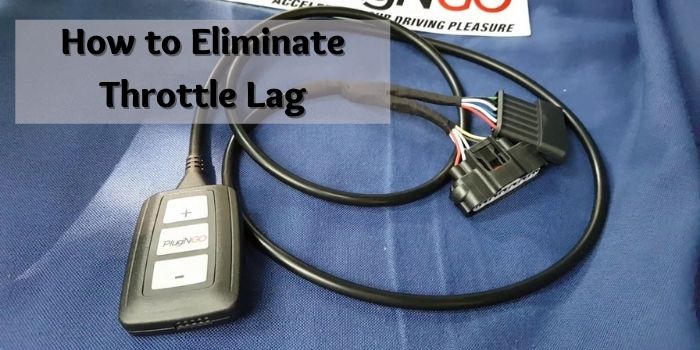When the traffic light turns green, how many times has your car failed to accelerate? Or maybe you’re already late for work, but your car won’t start. You keep slamming on the gas pedal, but your car takes an eternity to accelerate.
The “sponge pedal,” as it is widely known in current vehicles, seems to be a very bothersome feature. It is possible, however, to totally eliminate throttle lag, resulting in a response time of zero. You only need to know how to use the Engine Control Unit (ECU). So, let’s learn how to eliminate throttle lag here.
Read on to know more about the process.
How to Eliminate Throttle Lag

In a nutshell, we are going to learn how to alter the throttle signal to trick the ECU. There are three options.
The Throttle Response Controller
As we have already discussed, the ECU performs the task of controlling throttle lag. Electronic Throttle Control (ETC) always aims for the maximum response in order to take advantage of the car’s fuel. So, as a driver, you cannot feel the response of acceleration. A response controller can solve this issue! So, yes, getting the throttle response controller can be the easiest and most effective solution.
But what is a throttle controller?
Having a controller will enable you to use your car to its full extent. This controller can be installed directly into your car’s accelerator pedal. It increases the sensitivity of your throttle function (0-60 acceleration).
How To Install A Controller?
It is quite simple. Since it is a single wire connection, just plug it into your gas pedal, and you are good to go. To check if you have installed it properly, see if the controller beeps and flashes a light when the engine is sitting idly. A CAN Bus Interrupter signal is installed between the throttle and the engine. Your controller interrupts the signal that the gas pedal sends to the ECM and modifies it to the amount set by you.
How Can Throttle Response Controllers Eliminate Throttle Lag?
It increases the responsiveness of the gas pedal for smoother operations. Most vehicles in 2022 will come with either an ECU or a power steering system. Since cars are built with these technologies, there isn’t much choice for us to avoid getting a controller. And it makes sense too. The controller changes the sensitivity of your gas pedal, which creates more room for you to control speed. It speeds up the process by messing with the engine.
Tuning
Another way to adjust your vehicle’s throttle response is by tuning.
What is tuning?
It is a process through which you can adjust the electronic throttle body’s response to gas pedals. Tuning does help improve the throttle response.
How can tuning eliminate throttle lag?
It raises your redline and increases your boost for a better throttle response. Tuning also creates leaner mixtures on the stock ECM to make it more responsive to throttle input. Responsive throttle leads to faster acceleration.
Can you use tuning with throttle response controllers?
Yes! You can absolutely use tuning along with your throttle controller. While controllers increase the sensitivity of the gas pedal, tuning can further help you fine-tune fuel consumption and timing.
It depends on how responsive you want your throttle to be. If you are looking to gain more response and improve lag times, add a tune to make further adjustments. Tuning allows you to modify the amount of power that your engine is going to get. However, before that, install a controller to increase the sensitivity of pedal inputs.
Aftermarket Throttle
Throttle response control and tuning are not cheap. But there is a third way to eliminate lag. Aftermarket throttle is probably one of the most expensive ways to eliminate throttle lag.
What is an aftermarket throttle?
An aftermarket throttle is used to replace the factory throttle body. It modifies the intake manifold, which increases sensitivity.
How does aftermarket throttle work?
It plays with both the size and speed of your throttle. It enables your car to get a higher air volume at a faster speed to increase response and horsepower. The secret lies in the materials of the throttle. You need to make sure that the body has a larger diameter. A larger diameter will enable it to get a higher air volume. It will generate less friction to help the air reach its peak velocity.
Can You Tune Throttle Response?
Unfortunately, no. It’s impossible to fine-tune throttle response. However, you can certainly improve it! All you have to do is to find a throttle response controller that is compatible with your car. There are many types of controllers on the market. Pick one and then tune the adjustments available for the electronic throttle body.
Tips to Improve Engine Response:
Lastly, here is a list of tips that will improve your engine performance.
Check if all the sensors in your car are working properly
While inspecting the throttle lag, we frequently look for complicated solutions. A car’s sensors can reduce responsiveness. So check all the sensors first.
Check for Pipe Leakage
Any leakage in a car’s fuel pipes can hinder the engine’s performance as these pipes carry fuel to the throttle. Make sure to check for leaks.
Clean Clogged Fuel Filter
Cleaning the fuel filter is a simple but effective way to improve responsiveness. Given that all other systems are working correctly, a clogged filter can alone contribute greatly to decreasing responsiveness.
Active Codes in ECU
Finally, have a professional take a look at your car’s ECU. Any active code can create a cascade of failures that can reduce responsiveness or stop your engine entirely.
Conclusion
Throttle lag can be frustrating. Hopefully, this article will help you eliminate it and increase your car’s performance.
If you need any further help, let us know in the comments.